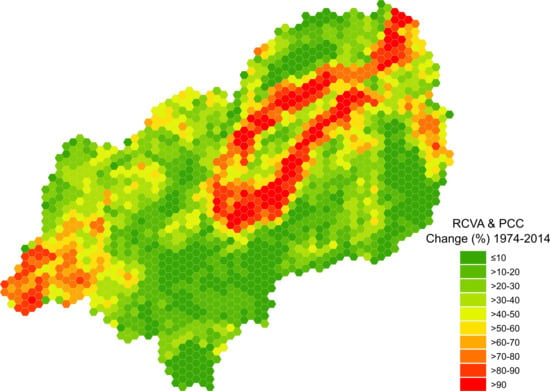Long-Term Land Use/Land Cover Change Assessment of the Kilombero Catchment in Tanzania Using Random Forest Classification and Robust Change Vector Analysis
Abstract
1. Introduction
2. Materials and Methods
2.1. Study Area
2.2. Satellite Data and Pre-Processing
2.3. Field Data and Other Reference Data
2.4. LULC Mapping
2.5. Change Assessment
2.6. Accuracy Assessment and Evaluation of Classification Results
3. Results and Discussion
3.1. LULC Classification
3.2. LULC Change
4. Conclusions
Supplementary Materials
Author Contributions
Founding
Acknowledgments
Conflicts of Interest
References
- Land-Use and Land-Cover Change: Local Processes and Global Impacts; Global Change—The IGBP Series; Lambin, E.F., Geist, H.J., Eds.; Springer: Berlin/Heidelberg, Germany, 2006; ISBN 978-3-540-32201-6. [Google Scholar]
- Rebelo, L.-M.; McCartney, M.P.; Finlayson, C.M. Wetlands of Sub-Saharan Africa: Distribution and contribution of agriculture to livelihoods. Wetl. Ecol Manag. 2010, 18, 557–572. [Google Scholar] [CrossRef]
- Darrah, S.E.; Shennan-Farpón, Y.; Loh, J.; Davidson, N.C.; Finlayson, C.M.; Gardner, R.C.; Walpole, M.J. Improvements to the Wetland Extent Trends (WET) index as a tool for monitoring natural and human-made wetlands. Ecol. Indic. 2019, 99, 294–298. [Google Scholar] [CrossRef]
- Davidson, N.C.; Fluet-Chouinard, E.; Finlayson, C.M. Global extent and distribution of wetlands: Trends and issues. Mar. Freshw. Res. 2018, 69, 620. [Google Scholar] [CrossRef]
- Ramsar Convention on Wetlands. Global Wetland Outlook: State of the World’s Wetlands and Their Services to People; Ramsar Convention Secretariat: Gland, Switzerland, 2018. [Google Scholar]
- Näschen, K.; Diekkrüger, B.; Evers, M.; Höllermann, B.; Steinbach, S.; Thonfeld, F. The Impact of Land Use/Land Cover Change (LULCC) on Water Resources in a Tropical Catchment in Tanzania under Different Climate Change Scenarios. Sustainability 2019, 11, 7083. [Google Scholar] [CrossRef]
- MacKay, H.; Finlayson, C.M.; Fernández-Prieto, D.; Davidson, N.; Pritchard, D.; Rebelo, L.-M. The role of Earth Observation (EO) technologies in supporting implementation of the Ramsar Convention on Wetlands. J. Environ. Manag. 2009, 90, 2234–2242. [Google Scholar] [CrossRef]
- Rebelo, L.-M.; Finlayson, C.M.; Strauch, A.; Rosenqvist, A.; Perennou, C.; Tøttrup, C.; Hilarides, L.; Paganini, M.; Wielaard, N.; Siegert, F.; et al. The Use of Earth Observation for Wetland Inventory, Assessment and Monitoring: An Information Source for the Ramsar Convention on Wetlands; Ramsar Technical Report No. 10; Ramsar Convention Secretariat: Gland, Switzerland, 2018. [Google Scholar]
- Darwin, R.; Tsigas, M.; Lewandrowski, J.; Raneses, A. Land use and cover in ecological economics. Ecol. Econ. 1996, 17, 157–181. [Google Scholar] [CrossRef]
- Beck, A.D. The Kilombero valley of south-central Tanganyika. East Afr. Geogr. Rev. 1964, 2, 37–43. [Google Scholar]
- Jätzold, R.; Baum, E. The Kilombero Valley (Tanzania). Characteristic Features of the Economic Geography of a Semihumid East African Flood Plain and Its Margins; IFO-Institut für Wirtschaftsforschung München; Weltforum Verlag: München, Germany, 1968. [Google Scholar]
- Näschen, K.; Diekkrüger, B.; Leemhuis, C.; Steinbach, S.; Seregina, L.S.; Thonfeld, F.; Van der Linden, R. Hydrological Modeling in Data-Scarce Catchments: The Kilombero Floodplain in Tanzania. Water 2018, 10, 599. [Google Scholar] [CrossRef]
- Senkondo, W.; Munishi, S.E.; Tumbo, M.; Nobert, J.; Lyon, S.W. Comparing Remotely-Sensed Surface Energy Balance Evapotranspiration Estimates in Heterogeneous and Data-Limited Regions: A Case Study of Tanzania’s Kilombero Valley. Remote Sens. 2019, 11, 1289. [Google Scholar] [CrossRef]
- Dronova, I.; Gong, P.; Wang, L.; Zhong, L. Mapping dynamic cover types in a large seasonally flooded wetland using extended principal component analysis and object-based classification. Remote Sens. Environ. 2015, 158, 193–206. [Google Scholar] [CrossRef]
- White, L.; Brisco, B.; Dabboor, M.; Schmitt, A.; Pratt, A. A Collection of SAR Methodologies for Monitoring Wetlands. Remote Sens. 2015, 7, 7615–7645. [Google Scholar] [CrossRef]
- Wohlfart, C.; Winkler, K.; Wendleder, A.; Roth, A. TerraSAR-X and Wetlands: A Review. Remote Sens. 2018, 10, 916. [Google Scholar] [CrossRef]
- Johansson, E.L.; Abdi, A.M. Mapping and quantifying perceptions of environmental change in Kilombero Valley, Tanzania. Ambio 2020, 49, 557–568. [Google Scholar] [CrossRef] [PubMed]
- Kato, F. Development of a major rice cultivation area in the Kilombero Valley, Tanzania. Afr. Study Monogr. 2007, 36, 3–18. [Google Scholar]
- Kirimi, F.; Thiong’o, K.; Gabiri, G.; Diekkrüger, B.; Thonfeld, F. Assessing seasonal land cover dynamics in the tropical Kilombero floodplain of East Africa. J. Appl. Remote Sens. 2018, 12, 1. [Google Scholar] [CrossRef]
- Leemhuis, C.; Thonfeld, F.; Näschen, K.; Steinbach, S.; Muro, J.; Strauch, A.; López, A.; Daconto, G.; Games, I.; Diekkrüger, B. Sustainability in the Food-Water-Ecosystem Nexus: The Role of Land Use and Land Cover Change for Water Resources and Ecosystems in the Kilombero Wetland, Tanzania. Sustainability 2017, 9, 1513. [Google Scholar] [CrossRef]
- Meijer, J.; Shames, S.; Giesen, P.; Scherr, S. Spatial Scenario Modelling to Support Integrated Landscape Management in the Kilombero Valley Landscape in Tanzania. A Case Study on Landscape Strategies to Achieve the Sustainable Development Goals; PBL Netherlands Environmental Assessment Agency: The Hague, The Netherlands, 2018. [Google Scholar]
- Msofe, N.K.; Sheng, L.; Lyimo, J. Land Use Change Trends and Their Driving Forces in the Kilombero Valley Floodplain, Southeastern Tanzania. Sustainability 2019, 11, 505. [Google Scholar] [CrossRef]
- Msofe, N.K.; Sheng, L.; Li, Z.; Lyimo, J. Impact of Land Use/Cover Change on Ecosystem Service Values in the Kilombero Valley Floodplain, Southeastern Tanzania. Forests 2020, 11, 109. [Google Scholar] [CrossRef]
- Munishi, S.; Jewitt, G. Degradation of Kilombero Valley Ramsar wetlands in Tanzania. Phys. Chem. Earth Parts 2019, 112, 216–227. [Google Scholar] [CrossRef]
- Muro, J.; Strauch, A.; Heinemann, S.; Steinbach, S.; Thonfeld, F.; Waske, B.; Diekkrüger, B. Land surface temperature trends as indicator of land use changes in wetlands. Int. J. Appl. Earth Obs. Geoinf. 2018, 70, 62–71. [Google Scholar] [CrossRef]
- Seki, H.A.; Shirima, D.D.; Mustaphi, C.J.C.; Marchant, R.; Munishi, P.K.T. The impact of land use and land cover change on biodiversity within and adjacent to Kibasira Swamp in Kilombero Valley, Tanzania. Afr. J. Ecol. 2018, 56, 518–527. [Google Scholar] [CrossRef]
- Hecheltjen, A.; Thonfeld, F.; Menz, G. Recent Advances in Remote Sensing Change Detection—A Review. In Land Use and Land Cover Mapping in Europe; Manakos, I., Braun, M., Eds.; Springer: Dordrecht, The Netherlands, 2014; Volume 18, pp. 145–178. ISBN 978-94-007-7968-6. [Google Scholar]
- Midekisa, A.; Holl, F.; Savory, D.J.; Andrade-Pacheco, R.; Gething, P.W.; Bennett, A.; Sturrock, H.J.W. Mapping land cover change over continental Africa using Landsat and Google Earth Engine cloud computing. PLoS ONE 2017, 12, e0184926. [Google Scholar] [CrossRef] [PubMed]
- Colwell, J.E.; Weber, F.P. Forest change detection. In Proceedings of the International Symposium on Remote Sensing of Environment, Ann Arbor, MI, USA, 11–15 May 1981; Volume 15, pp. 839–852. [Google Scholar]
- Xian, G.; Homer, C.; Fry, J. Updating the 2001 National Land Cover Database land cover classification to 2006 by using Landsat imagery change detection methods. Remote Sens. Environ. 2009, 113, 1133–1147. [Google Scholar] [CrossRef]
- Leemhuis, C.; Amler, E.; Diekkrüger, B.; Gabiri, G.; Näschen, K. East African wetland-catchment data base for sustainable wetland management. Proc. Int. Assoc. Hydrol. Sci. 2016, 374, 123–128. [Google Scholar] [CrossRef]
- Kottek, M.; Grieser, J.; Beck, C.; Rudolf, B.; Rubel, F. World Map of the Köppen-Geiger climate classification updated. Meteorol. Z. 2006, 15, 259–263. [Google Scholar] [CrossRef]
- Peel, M.C.; Finlayson, B.L.; McMahon, T.A. Updated world map of the Köppen-Geiger climate classification. Hydrol. Earth Syst. Sci. 2007, 11, 1633–1644. [Google Scholar] [CrossRef]
- Lillesø, J.-P.B.; van Breugel, P.; Kindt, R.; Mbago, F.; Moshi, H.N.; Ndangalasi, H.J.; Uronu, L.O.N.; Jamnadass, R.; Graudal, L. Potential Natural Vegetation of Eastern Africa (Ethiopia, Kenya, Malawi, Rwanda, Tanzania, Uganda and Zambia). Volume 10. Atlas and Tree Species Composition for Tanzania; Department of Geoscience and Natural Resource Management, University of Copenhagen: Copenhagen, Denmark, 2014; ISBN 978-87-7903-622-2. [Google Scholar]
- Koutsouris, A.J.; Chen, D.; Lyon, S.W. Comparing global precipitation data sets in eastern Africa: A case study of Kilombero Valley, Tanzania: Comparing global precipitation data sets in Tanzania, East Africa. Int. J. Climatol. 2016, 36, 2000–2014. [Google Scholar] [CrossRef]
- Ntongani, W.A.; Andrew, S.M. Bird species composition and diversity in habitats with different disturbance histories at Kilombero Wetland, Tanzania. OJE 2013, 3, 482–488. [Google Scholar] [CrossRef]
- Lyon, S.W.; Koutsouris, A.; Scheibler, F.; Jarsjö, J.; Mbanguka, R.; Tumbo, M.; Robert, K.K.; Sharma, A.N.; van der Velde, Y. Interpreting characteristic drainage timescale variability across Kilombero Valley, Tanzania. Hydrol. Process. 2015, 29, 1912–1924. [Google Scholar] [CrossRef]
- RBWO the Rufiji Basin Water Office (RBWO) Discharge Database. Available online: http://www.riversnetwork.org/rbo/index.php/river-blogs/central-africa/item/2055-the-rufiji-basin-water-office-rbwo (accessed on 9 July 2017).
- Siima, S.B.; Munishi, P.K.T.; Ngaga, Y.M.; Navrud, S. Estimating direct use value of Kilombero Ramsar Site based on market price method. Tanzan. J. For. Nat. Conserv. 2012, 81, 133–146. [Google Scholar]
- Nindi, S.J.; Maliti, H.; Bakari, S.; Kija, H.; Machoke, M. Conflicts over Land and Water Resources in the Kilombero Valley Floodplain, Tanzania. Afr. Study Monogr. 2014, 50, 173–190. [Google Scholar]
- Koskinen, J.; Leinonen, U.; Vollrath, A.; Ortmann, A.; Lindquist, E.; d’Annunzio, R.; Pekkarinen, A.; Käyhkö, N. Participatory mapping of forest plantations with Open Foris and Google Earth Engine. ISPRS J. Photogramm. Remote Sens. 2019, 148, 63–74. [Google Scholar] [CrossRef]
- Vogelmann, J.E.; Gallant, A.L.; Shi, H.; Zhu, Z. Perspectives on monitoring gradual change across the continuity of Landsat sensors using time-series data. Remote Sens. Environ. 2016, 185, 258–270. [Google Scholar] [CrossRef]
- Zhu, Z.; Wang, S.; Woodcock, C.E. Improvement and expansion of the Fmask algorithm: Cloud, cloud shadow, and snow detection for Landsats 4–8, and Sentinel 2 images. Remote Sens. Environ. 2015, 159, 269–277. [Google Scholar] [CrossRef]
- Zhu, Z.; Woodcock, C.E. Object-based cloud and cloud shadow detection in Landsat imagery. Remote Sens. Environ. 2012, 118, 83–94. [Google Scholar] [CrossRef]
- Zha, Y.; Gao, J.; Ni, S. Use of normalized difference built-up index in automatically mapping urban areas from TM imagery. Int. J. Remote Sens. 2003, 24, 583–594. [Google Scholar] [CrossRef]
- Tucker, C.J. Red and photographic infrared linear combinations for monitoring vegetation. Remote Sens. Environ. 1979, 8, 127–150. [Google Scholar] [CrossRef]
- McFeeters, S.K. The use of the Normalized Difference Water Index (NDWI) in the delineation of open water features. Int. J. Remote Sens. 1996, 17, 1425–1432. [Google Scholar] [CrossRef]
- Crist, E.P.; Cicone, R.C. A Physically-Based Transformation of Thematic Mapper Data—The TM Tasseled Cap. IEEE Trans. Geosci. Remote Sens. 1984, GE-22, 256–263. [Google Scholar] [CrossRef]
- Kauth, R.; Thomas, G. The Tasselled Cap—A Graphic Description of the Spectral-Temporal Development of Agricultural Crops as Seen by LANDSAT; Purdue: West Lafayette, IN, USA, 1976. [Google Scholar]
- Crist, E.P. A TM Tasseled Cap equivalent transformation for reflectance factor data. Remote Sens. Environ. 1985, 17, 301–306. [Google Scholar] [CrossRef]
- Cazals, C.; Rapinel, S.; Frison, P.-L.; Bonis, A.; Mercier, G.; Mallet, C.; Corgne, S.; Rudant, J.-P. Mapping and Characterization of Hydrological Dynamics in a Coastal Marsh Using High Temporal Resolution Sentinel-1A Images. Remote Sens. 2016, 8, 570. [Google Scholar] [CrossRef]
- Davranche, A.; Poulin, B.; Lefebvre, G. Mapping flooding regimes in Camargue wetlands using seasonal multispectral data. Remote Sens. Environ. 2013, 138, 165–171. [Google Scholar] [CrossRef]
- Schlaffer, S.; Chini, M.; Dettmering, D.; Wagner, W. Mapping Wetlands in Zambia Using Seasonal Backscatter Signatures Derived from ENVISAT ASAR Time Series. Remote Sens. 2016, 8, 402. [Google Scholar] [CrossRef]
- Flood, N. Seasonal Composite Landsat TM/ETM + Images Using the Medoid (a Multi-Dimensional Median). Remote Sens. 2013, 5, 6481–6500. [Google Scholar] [CrossRef]
- Flood, N.; Danaher, T.; Gill, T.; Gillingham, S. An Operational Scheme for Deriving Standardised Surface Reflectance from Landsat TM/ETM+ and SPOT HRG Imagery for Eastern Australia. Remote Sens. 2013, 5, 83–109. [Google Scholar] [CrossRef]
- Frantz, D. FORCE—Landsat + Sentinel-2 Analysis Ready Data and Beyond. Remote Sens. 2019, 11, 1124. [Google Scholar] [CrossRef]
- Frantz, D.; Röder, A.; Stellmes, M.; Hill, J. Phenology-adaptive pixel-based compositing using optical earth observation imagery. Remote Sens. Environ. 2017, 190, 331–347. [Google Scholar] [CrossRef]
- Frantz, D.; Stellmes, M.; Röder, A.; Udelhoven, T.; Mader, S.; Hill, J. Improving the Spatial Resolution of Land Surface Phenology by Fusing Medium- and Coarse-Resolution Inputs. IEEE Trans. Geosci. Remote Sens. 2016, 54, 4153–4164. [Google Scholar] [CrossRef]
- Griffiths, P.; van der Linden, S.; Kuemmerle, T.; Hostert, P. A Pixel-Based Landsat Compositing Algorithm for Large Area Land Cover Mapping. IEEE J. Sel. Top. Appl. Earth Obs. Remote Sens. 2013, 6, 2088–2101. [Google Scholar] [CrossRef]
- Nelson, K.J.; Steinwand, D. A Landsat Data Tiling and Compositing Approach Optimized for Change Detection in the Conterminous United States. Photogramm. Eng. Remote Sens. 2015, 81, 573–586. [Google Scholar] [CrossRef]
- Vuolo, F.; Ng, W.-T.; Atzberger, C. Smoothing and gap-filling of high resolution multi-spectral time series: Example of Landsat data. Int. J. Appl. Earth Obs. Geoinf. 2017, 57, 202–213. [Google Scholar] [CrossRef]
- White, J.C.; Wulder, M.A.; Hobart, G.W.; Luther, J.E.; Hermosilla, T.; Griffiths, P.; Coops, N.C.; Hall, R.J.; Hostert, P.; Dyk, A.; et al. Pixel-Based Image Compositing for Large-Area Dense Time Series Applications and Science. Can. J. Remote Sens. 2014, 40, 192–212. [Google Scholar] [CrossRef]
- Azzari, G.; Lobell, D.B. Landsat-based classification in the cloud: An opportunity for a paradigm shift in land cover monitoring. Remote Sens. Environ. 2017, 202, 64–74. [Google Scholar] [CrossRef]
- Esch, T.; Metz, A.; Marconcini, M.; Keil, M. Combined use of multi-seasonal high and medium resolution satellite imagery for parcel-related mapping of cropland and grassland. Int. J. Appl. Earth Obs. Geoinf. 2014, 28, 230–237. [Google Scholar] [CrossRef]
- Hansen, M.C.; Egorov, A.; Potapov, P.V.; Stehman, S.V.; Tyukavina, A.; Turubanova, S.A.; Roy, D.P.; Goetz, S.J.; Loveland, T.R.; Ju, J.; et al. Monitoring conterminous United States (CONUS) land cover change with Web-Enabled Landsat Data (WELD). Remote Sens. Environ. 2014, 140, 466–484. [Google Scholar] [CrossRef]
- Mack, B.; Leinenkugel, P.; Kuenzer, C.; Dech, S. A semi-automated approach for the generation of a new land use and land cover product for Germany based on Landsat time-series and Lucas in-situ data. Remote Sens. Lett. 2017, 8, 244–253. [Google Scholar] [CrossRef]
- Müller, H.; Rufin, P.; Griffiths, P.; Barros Siqueira, A.J.; Hostert, P. Mining dense Landsat time series for separating cropland and pasture in a heterogeneous Brazilian savanna landscape. Remote Sens. Environ. 2015, 156, 490–499. [Google Scholar] [CrossRef]
- Rufin, P.; Müller, H.; Pflugmacher, D.; Hostert, P. Land use intensity trajectories on Amazonian pastures derived from Landsat time series. Int. J. Appl. Earth Obs. Geoinf. 2015, 41, 1–10. [Google Scholar] [CrossRef]
- Canty, M.J.; Nielsen, A.A. Automatic radiometric normalization of multitemporal satellite imagery with the iteratively re-weighted MAD transformation. Remote Sens. Environ. 2008, 112, 1025–1036. [Google Scholar] [CrossRef]
- Nielsen, A.A. The Regularized Iteratively Reweighted MAD Method for Change Detection in Multi- and Hyperspectral Data. IEEE Trans. Image Process. 2007, 16, 463–478. [Google Scholar] [CrossRef]
- Farr, T.G.; Kobrick, M. Shuttle radar topography mission produces a wealth of data. Eos Trans. AGU 2000, 81, 583–585. [Google Scholar] [CrossRef]
- Santillan, J.R.; Makinano-Santillan, M. Vertical accuracy assessment of 30-m resolution ALOS, ASTER, and SRTM global DEMs overnortheastern Mindanao, Philippines. ISPRS Int. Arch. Photogramm. Remote Sens. Spat. Inf. Sci. 2016, XLI-B4, 149–156. [Google Scholar] [CrossRef]
- Dinesen, L.; Lehmberg, T.; Rahner, M.C.; Fjeldså, J. Conservation priorities for the forests of the Udzungwa Mountains, Tanzania, based on primates, duikers and birds. Biol. Conserv. 2001, 99, 223–236. [Google Scholar] [CrossRef]
- Riley, S.J.; DeGloria, S.D.; Elliot, R. A terrain ruggedness index that quantifies topographic heterogeneity. Intermt. Journcal Sci. 1999, 5, 23–27. [Google Scholar]
- Ruszkiczay-Rüdiger, Z.; Fodor, L.; Horváth, E.; Telbisz, T. Discrimination of fluvial, eolian and neotectonic features in a low hilly landscape: A DEM-based morphotectonic analysis in the Central Pannonian Basin, Hungary. Geomorphology 2009, 104, 203–217. [Google Scholar] [CrossRef]
- Gallant, J.C.; Wilson, J.P. Primary topographic attributes. In Terrain Analysis: Principles and Applications; Wilson, J.P., Gallant, J.C., Eds.; John Wiley & Sons: New York, NY, USA, 2000; pp. 51–85. [Google Scholar]
- Jenness, J. Topographic Position Index (tpi _jen.avx) extension for ArcView 3.x; Version 1.2; Jenness Enterprises: Flagstaff, AZ, USA, 2006. [Google Scholar]
- Beven, K.J.; Kirkby, M.J. A physically based, variable contributing area model of basin hydrology/Un modèle à base physique de zone d’appel variable de l’hydrologie du bassin versant. Hydrol. Sci. Bull. 1979, 24, 43–69. [Google Scholar] [CrossRef]
- Evans, J.S.; Oakleaf, J.; Cushman, S.A.; Theobald, D. An ArcGIS Toolbox for Surface Gradient and Geomorphometric Modeling. version 2.0-0. 2014. Available online: http://evansmurphy.wix.com/evansspatial (accessed on 28 January 2020).
- Planet Rapid Eye Imagery Product Specifications. Version 6.1. 2016. Available online: https://www.planet.com/products/satellite-imagery/files/160625-RapidEye%20Image-Product-Specifications.pdf (accessed on 28 January 2020).
- Platts, P.J.; Burgess, N.D.; Gereau, R.E.; Lovett, J.C.; Marshall, A.R.; McCLEAN, C.J.; Pellikka, P.K.E.; Swetnam, R.D.; Marchant, R. Delimiting tropical mountain ecoregions for conservation. Environ. Conserv. 2011, 38, 312–324. [Google Scholar] [CrossRef]
- Breiman, L. Random Forests. Mach. Learn. 2001, 45, 5–32. [Google Scholar] [CrossRef]
- Corcoran, J.; Knight, J.; Pelletier, K.; Rampi, L.; Wang, Y. The Effects of Point or Polygon Based Training Data on RandomForest Classification Accuracy of Wetlands. Remote Sens. 2015, 7, 4002–4025. [Google Scholar] [CrossRef]
- Millard, K.; Richardson, M. On the Importance of Training Data Sample Selection in Random Forest Image Classification: A Case Study in Peatland Ecosystem Mapping. Remote Sens. 2015, 7, 8489–8515. [Google Scholar] [CrossRef]
- Liaw, A.; Wiener, M. Classification and Regression by randomForest. R News 2002, 2, 18–22. [Google Scholar]
- R Core Team. R: A Language and Environment for Statistical Computing; R Foundation for Statistical Computing: Vienna, Austria, 2019. [Google Scholar]
- Canty, M.J. Image Analysis, Classification and Change Detection in Remote Sensing: With Algorithms for Python, 4th ed.; CRC Press, Taylor & Francis Group: Boca Raton, FL, USA, 2019. [Google Scholar]
- Pelletier, C.; Valero, S.; Inglada, J.; Champion, N.; Dedieu, G. Assessing the robustness of Random Forests to map land cover with high resolution satellite image time series over large areas. Remote Sens. Environ. 2016, 187, 156–168. [Google Scholar] [CrossRef]
- Pal, M. Random forest classifier for remote sensing classification. Int. J. Remote Sens. 2005, 26, 217–222. [Google Scholar] [CrossRef]
- Waske, B.; van der Linden, S.; Oldenburg, C.; Jakimow, B.; Rabe, A.; Hostert, P. imageRF—A user-oriented implementation for remote sensing image analysis with Random Forests. Environ. Model. Softw. 2012, 35, 192–193. [Google Scholar] [CrossRef]
- Horning, N.; Leutner, B.; Wegmann, M. Land cover or image classification approaches. In Remote Sensing and GIS for Ecologists. Using Open Source Software; Wegmann, M., Leutner, B., Eds.; Pelagic Publishing: Exeter, UK, 2016. [Google Scholar]
- Chen, C.; Liaw, A.; Breiman, L. Using Random Forest to Learn Imbalanced Data; University of Berkeley: Berkeley, CA, USA, 2004. [Google Scholar]
- Singh, A. Review Article Digital change detection techniques using remotely-sensed data. Int. J. Remote Sens. 1989, 10, 989–1003. [Google Scholar] [CrossRef]
- Thonfeld, F.; Feilhauer, H.; Braun, M.; Menz, G. Robust Change Vector Analysis (RCVA) for multi-sensor very high resolution optical satellite data. Int. J. Appl. Earth Obs. Geoinf. 2016, 50, 131–140. [Google Scholar] [CrossRef]
- Malila, W.A. Change vector analysis: An approach for detecting forest changes with Landsat. In Proceedings of the LARS Symposia, West Lafayette, IN, USA, 3–6 June 1980; Volume 385, pp. 326–335. [Google Scholar]
- Bovolo, F.; Marchesi, S.; Bruzzone, L. A nearly lossless 2d representation and characterization of change information in multispectral images. In Proceedings of the 2010 IEEE International Geoscience and Remote Sensing Symposium, Honolulu, HI, USA, 25–30 July 2010; pp. 3074–3077. [Google Scholar]
- Bovolo, F.; Bruzzone, L. A Theoretical Framework for Unsupervised Change Detection Based on Change Vector Analysis in the Polar Domain. IEEE Trans. Geosci. Remote Sens. 2007, 45, 218–236. [Google Scholar] [CrossRef]
- Michalek, J.L.; Wagner, T.W.; Luczkovich, J.J.; Stoffle, R.W. Multispectral change vector analysis for monitoring coastal marine environments. Photogramm. Eng. Remote Sens. 1993, 381–384. [Google Scholar]
- Otsu, N. A Threshold Selection Method from Gray-Level Histograms. IEEE Trans. Syst. Man Cybern. 1979, 9, 62–66. [Google Scholar] [CrossRef]
- Foody, G.M. Status of land cover classification accuracy assessment. Remote Sens. Environ. 2002, 80, 185–201. [Google Scholar] [CrossRef]
- Olofsson, P.; Foody, G.M.; Herold, M.; Stehman, S.V.; Woodcock, C.E.; Wulder, M.A. Good practices for estimating area and assessing accuracy of land change. Remote Sens. Environ. 2014, 148, 42–57. [Google Scholar] [CrossRef]
- Carrasco, L.; O’Neil, A.W.; Morton, R.D.; Rowland, C.S. Evaluating Combinations of Temporally Aggregated Sentinel-1, Sentinel-2 and Landsat 8 for Land Cover Mapping with Google Earth Engine. Remote Sens. 2019, 11, 288. [Google Scholar] [CrossRef]
- Daconto, G.; Games, I.; Lukumbuzya, K.; Raijmakers, F. Integrated Management Plan for the Kilombero Valley Ramsar Site—Foundation Report. Available online: https://kilomberovalley.files.wordpress.com/2019/02/kvrs-imp_foundation-2018-09.pdf (accessed on 15 January 2020).
- Davidson, N.C. How much wetland has the world lost? Long-term and recent trends in global wetland area. Mar. Freshw. Res. 2014, 65, 934. [Google Scholar] [CrossRef]
- Twisa, S.; Buchroithner, M.F. Land-Use and Land-Cover (LULC) Change Detection in Wami River Basin, Tanzania. Land 2019, 8, 136. [Google Scholar] [CrossRef]
- Alavaisha, E.; Manzoni, S.; Lindborg, R. Different agricultural practices affect soil carbon, nitrogen and phosphorous in Kilombero-Tanzania. J. Environ. Manag. 2019, 234, 159–166. [Google Scholar] [CrossRef] [PubMed]
- Kwesiga, J.; Grotelüschen, K.; Neuhoff, D.; Senthilkumar, K.; Döring, T.F.; Becker, M. Site and Management Effects on Grain Yield and Yield Variability of Rainfed Lowland Rice in the Kilombero Floodplain of Tanzania. Agronomy 2019, 9, 632. [Google Scholar] [CrossRef]
- Kopittke, P.M.; Menzies, N.W.; Wang, P.; McKenna, B.A.; Lombi, E. Soil and the intensification of agriculture for global food security. Environ. Int. 2019, 132, 105078. [Google Scholar] [CrossRef]
- Sharma, R.; Rimal, B.; Baral, H.; Nehren, U.; Paudyal, K.; Sharma, S.; Rijal, S.; Ranpal, S.; Acharya, R.P.; Alenazy, A.A.; et al. Impact of Land Cover Change on Ecosystem Services in a Tropical Forested Landscape. Resources 2019, 8, 18. [Google Scholar] [CrossRef]
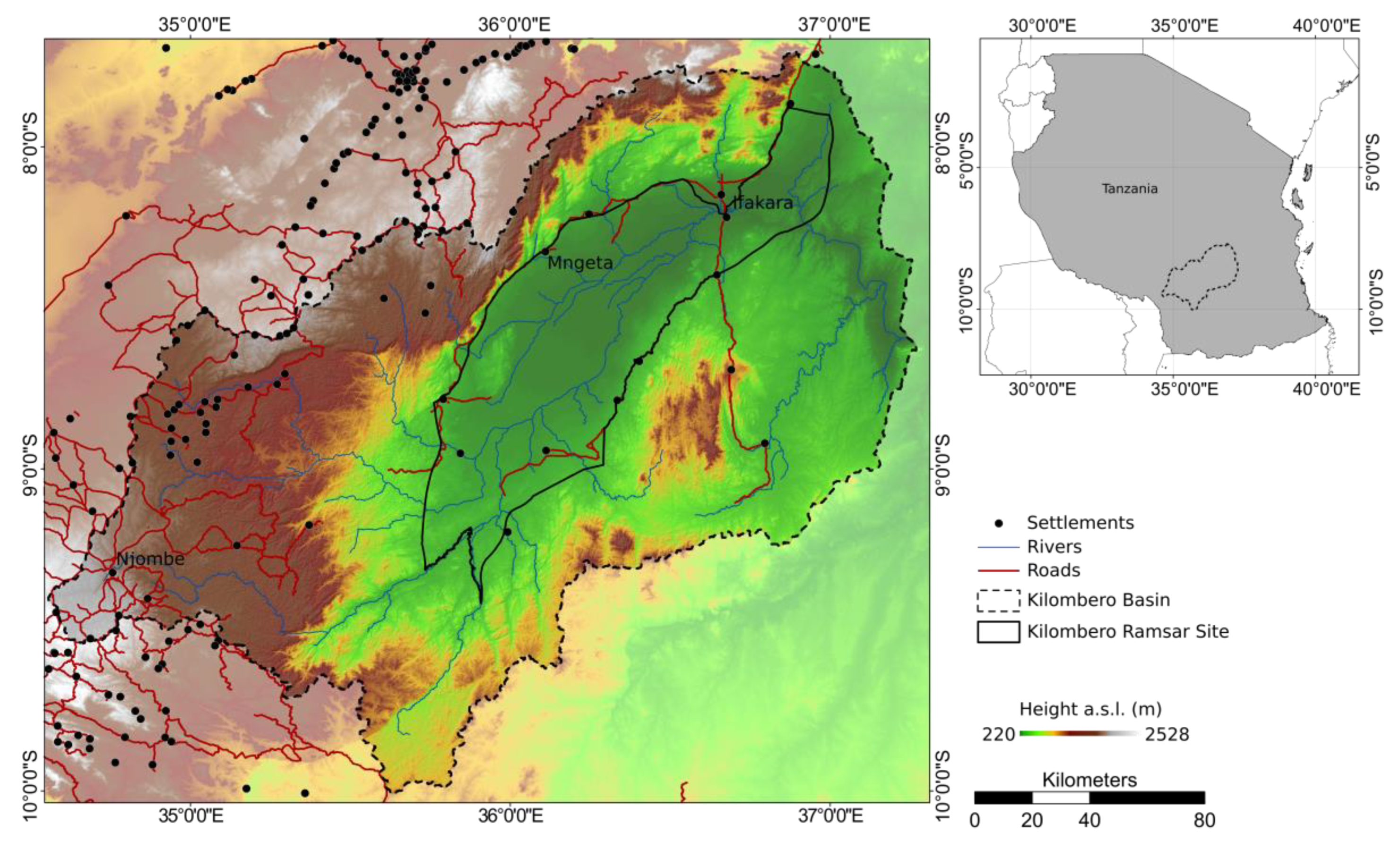
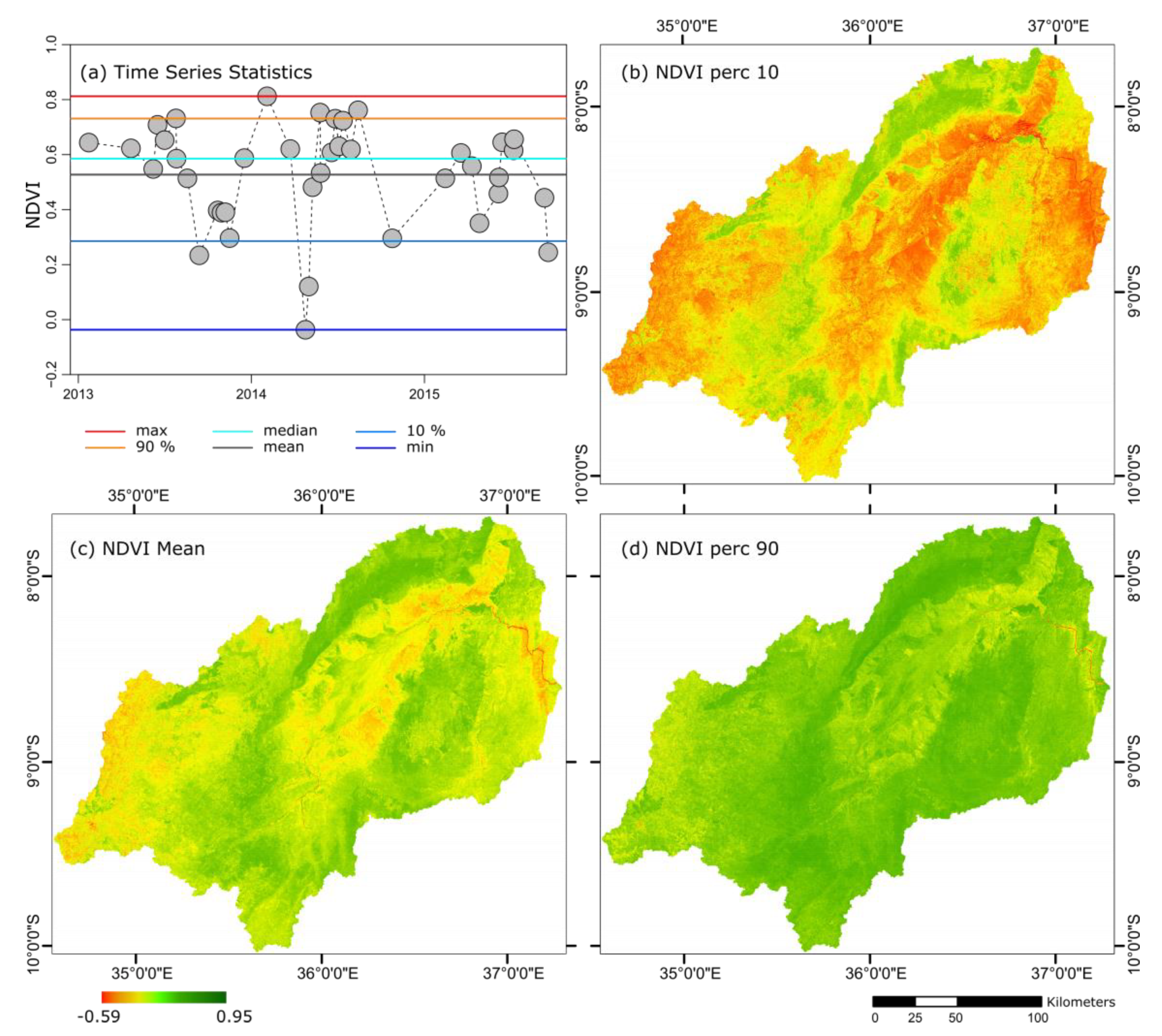
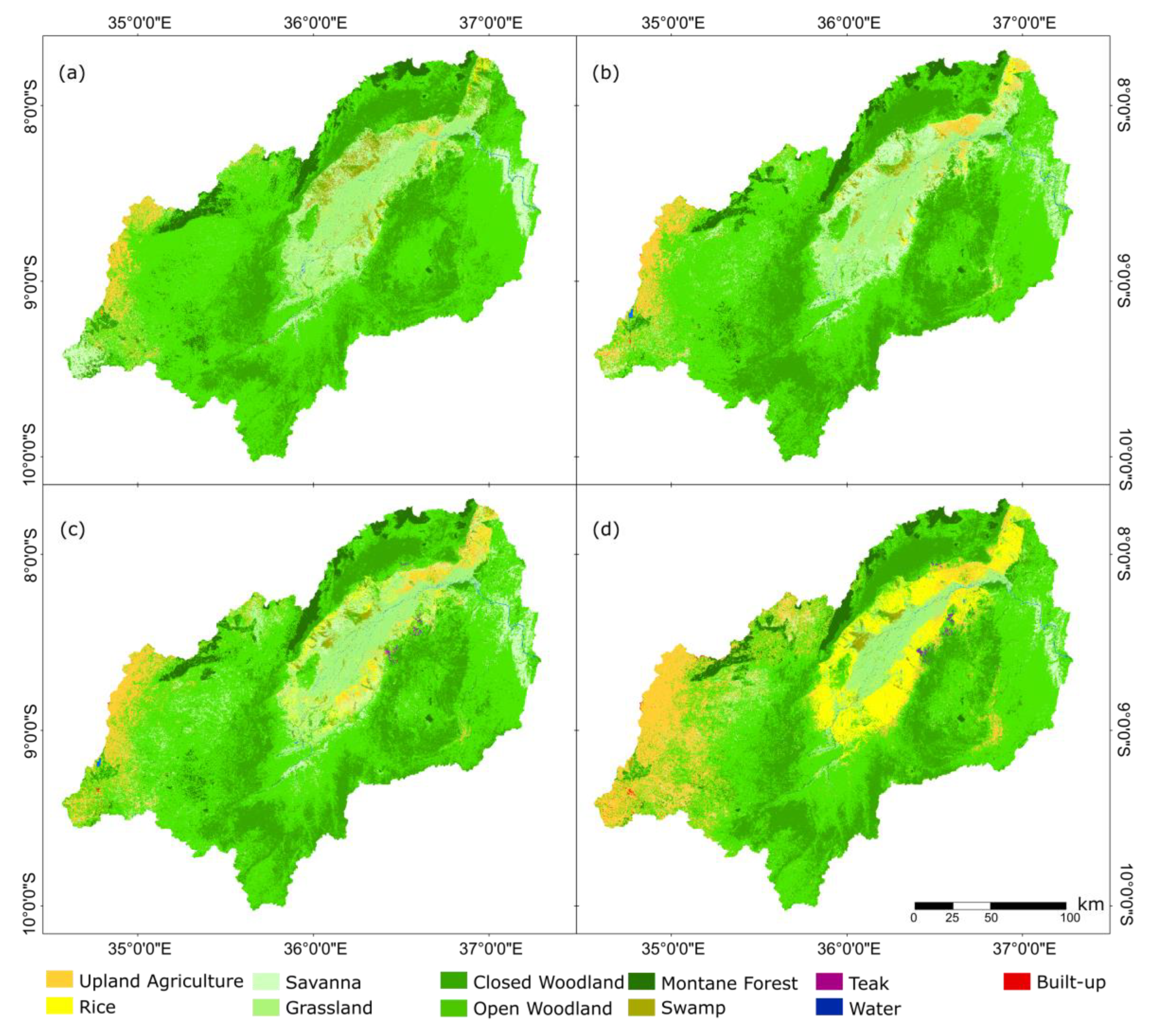
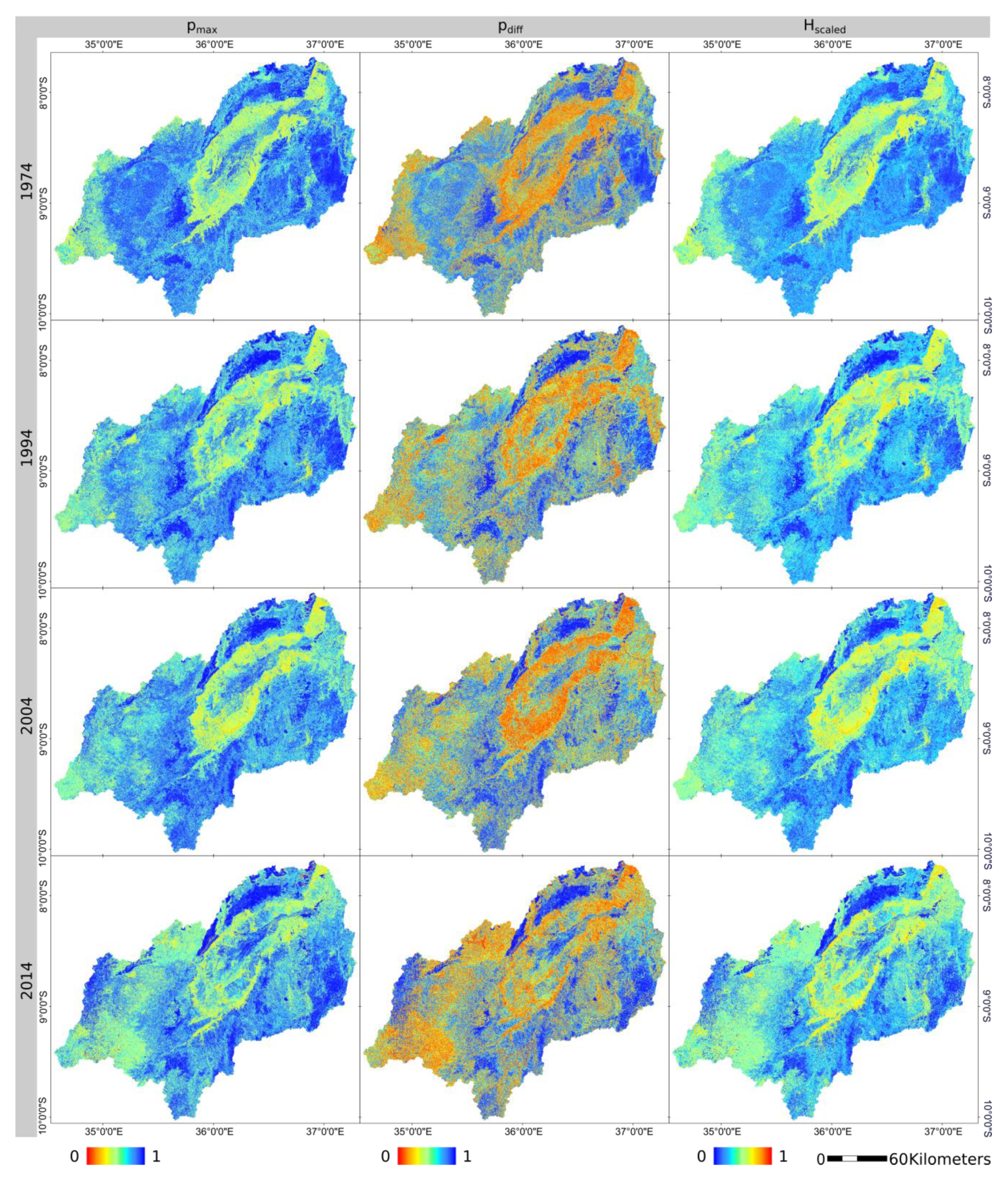
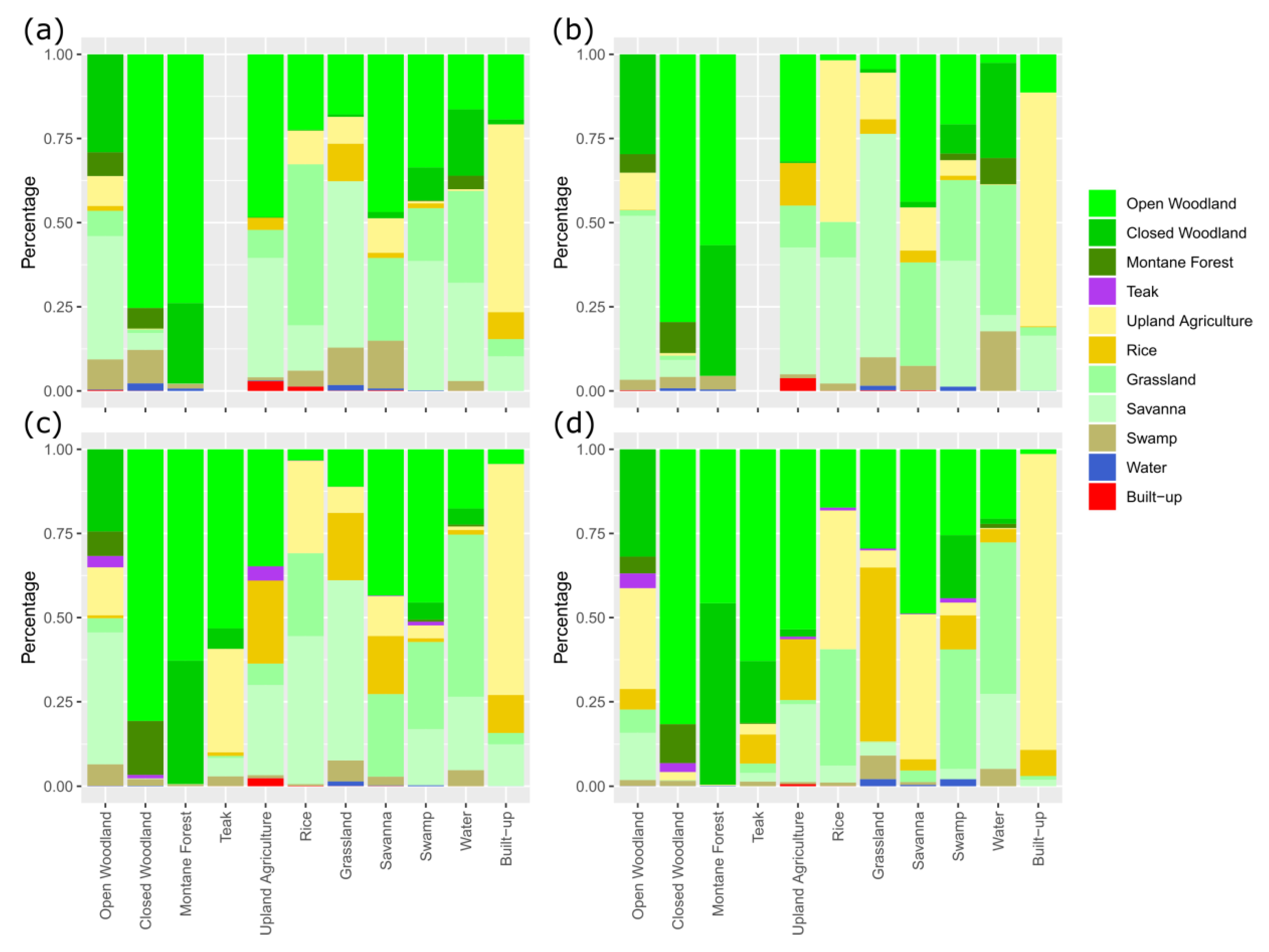
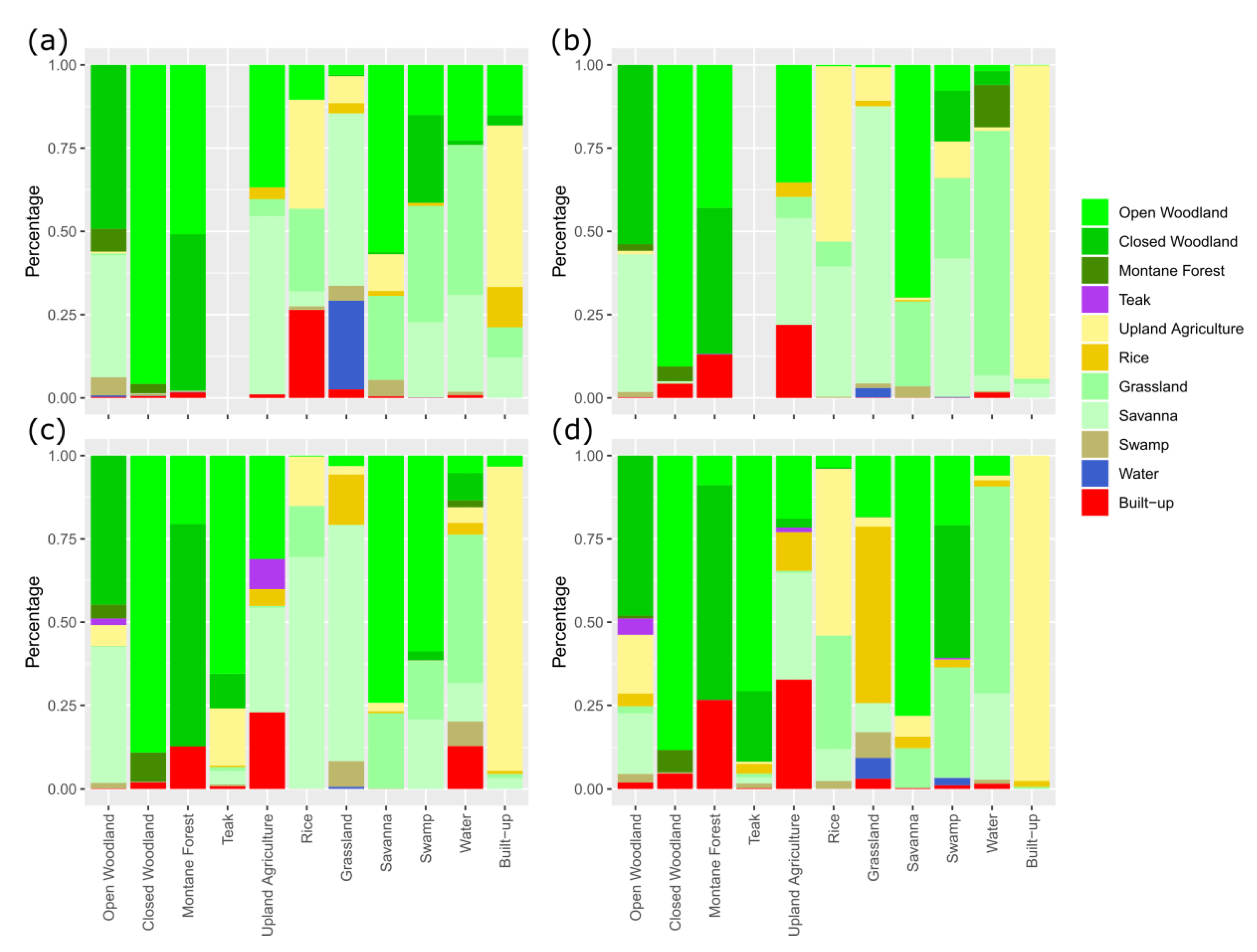
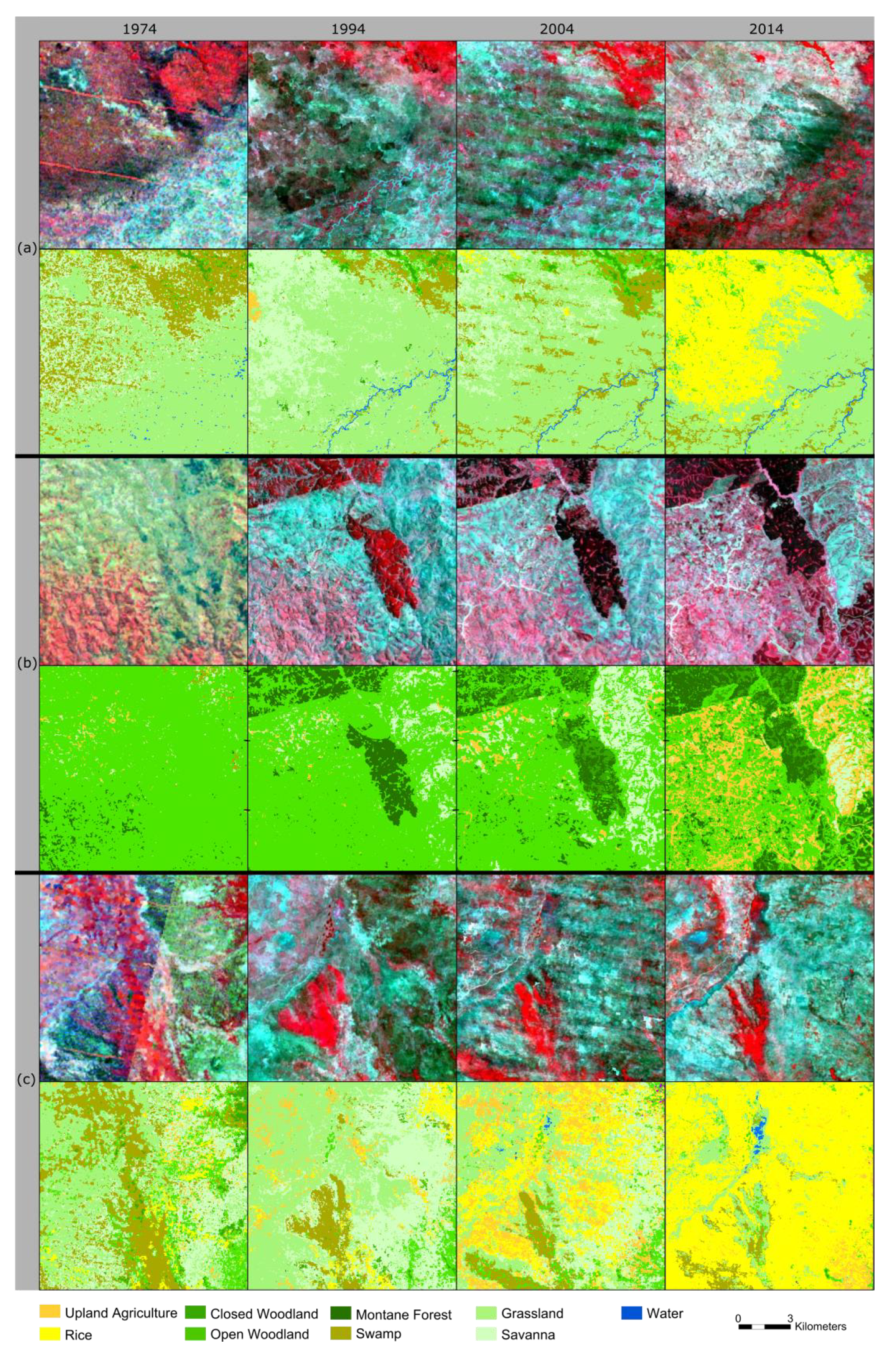
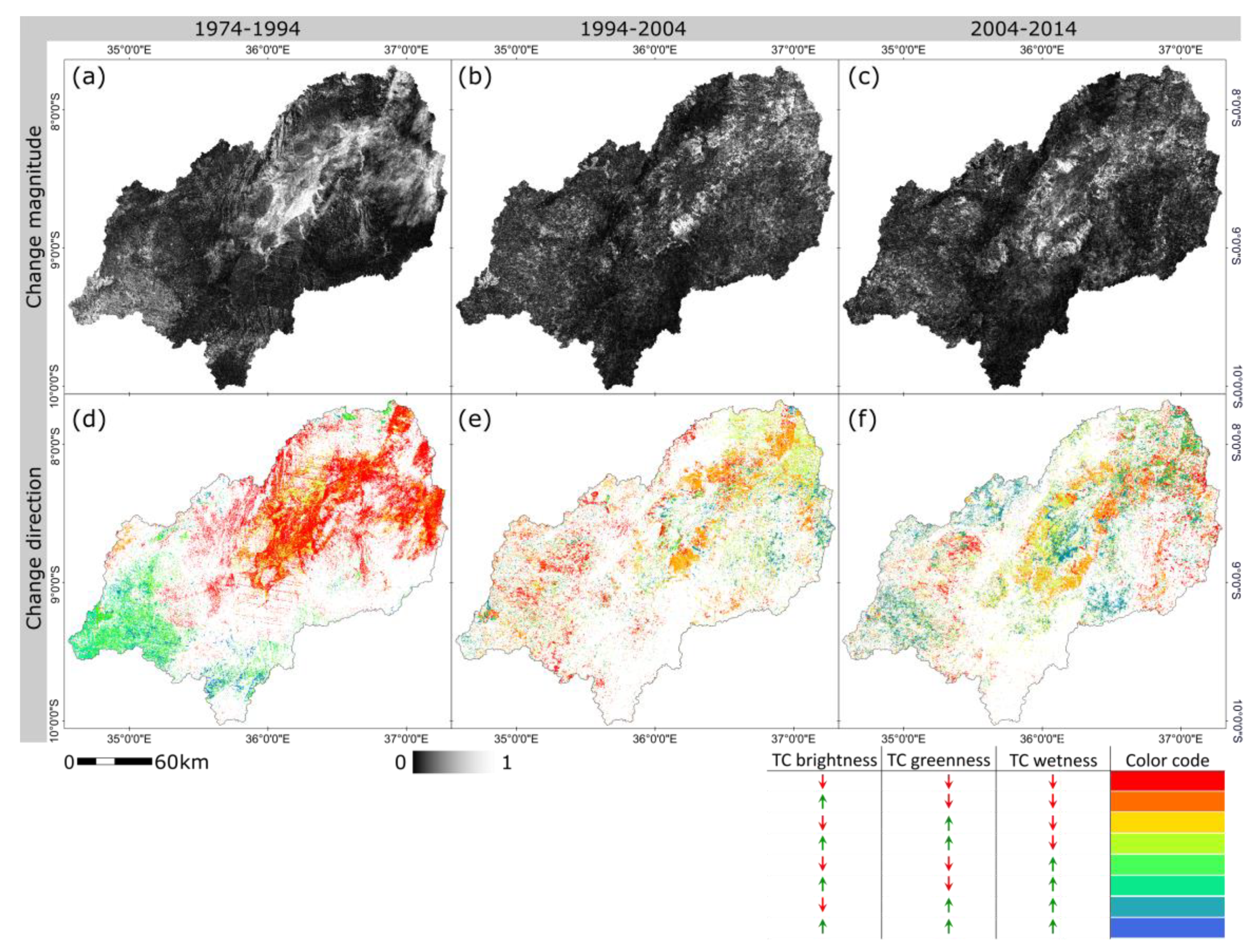

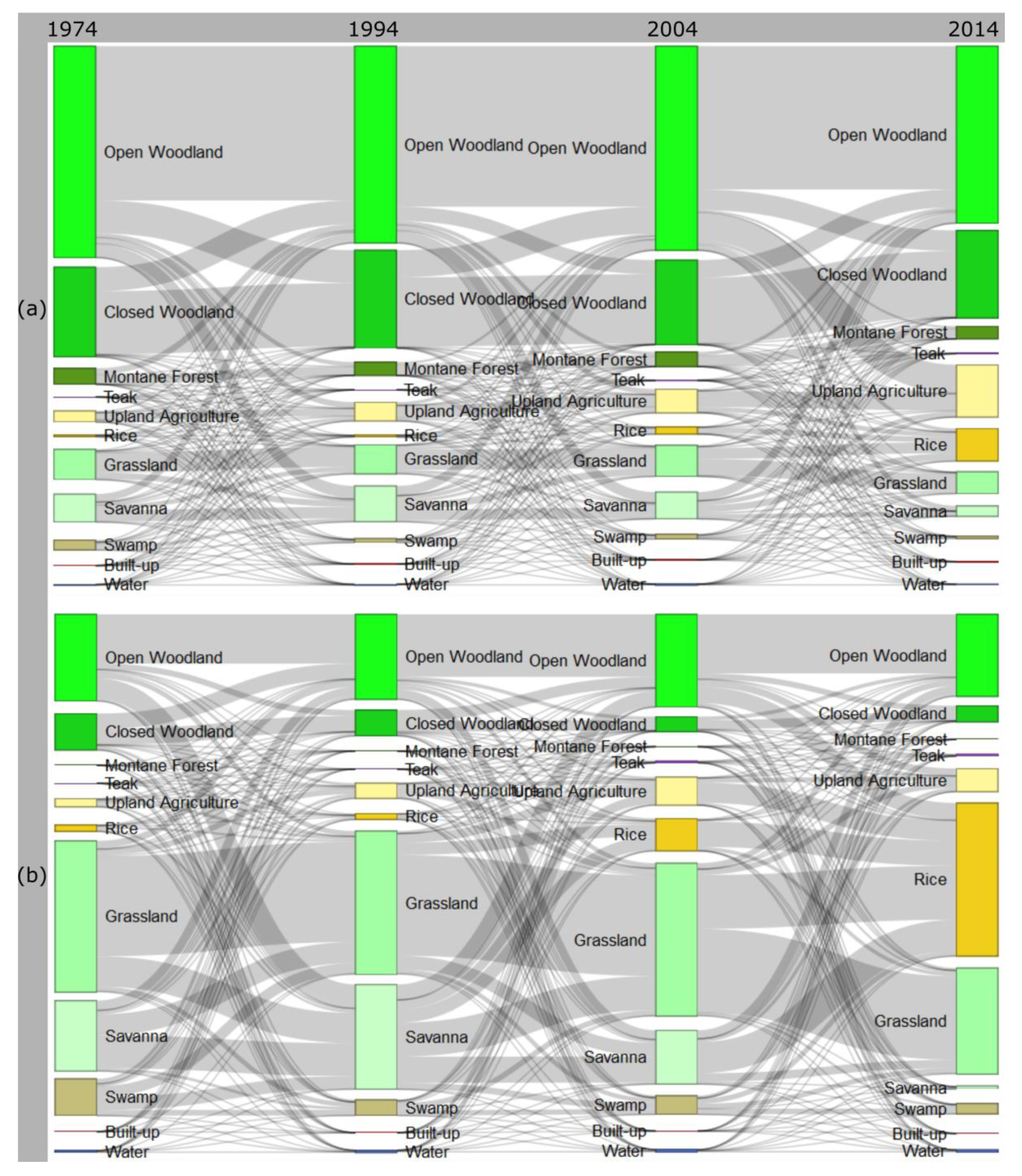
| Target Year | Spatial Resolution | Sensor | Specifications | No. of Images |
|---|---|---|---|---|
| 1974 ± 5 year | 60 m resampled to 30 m | Landsat-1/2 MSS | Pre-Collection Level-1 | 17 |
| 1994 ± 1 year | 30 m | Landsat-5 TM | SR Level-2 Science Products | 100 |
| 2004 ± 1 year | 30 m | Landsat-5 TM, Landsat-7 ETM+ | SR Level-2 Science Products | 209 |
| 2014 ± 1 year | 30 m | Landsat-7 ETM+, Landsat-8 OLI | SR Level-2 Science Products | 462 |
| Class | Description |
|---|---|
| Montane forest | Closed-canopy evergreen forests of the Eastern Arc Ecoregion [81] |
| Closed woodland | Areas Dominated by closed tree vegetation; tree plantations other than teak may be included |
| Open woodland | Sparse tree vegetation, mainly Miombo dry forests (Brachystegia longifolia), and to a minor degree plantations in early stages of afforestation |
| Teak plantation | Commercial teak plantation (Tectona grandis); few other species may be present in the understory, but to a negligible degree |
| Swamp | Shrubby vegetation adapted to waterlogged soils |
| Grassland | Natural flood grassland dominated by sedges such as Cyperus distans [11] |
| Savanna | All non-flooded open grasslands; usually with isolated trees [11] |
| Upland agriculture | Maize, tubers, vegetables and other food crops usually grown in mosaics of small patches and in crop rotation |
| Rice | Lowland rice agricultural fields |
| Built-up | Man-made artificial surfaces like metals or tarmac |
| Water | Open water, including streams, ponds, and lakes |
| . | Estimated Area (ha) | PA | UA | OA |
|---|---|---|---|---|
| Built-up | 49,986 ± 38,294 | NA ± NA | 0 ± 0 | |
| Closed woodland | 1,017,708 ± 129,363 | 0.79 ± 0.08 | 0.70 ± 0.09 | |
| Upland agriculture | 171,522 ± 67,311 | 0.45 ± 0.18 | 0.30 ± 0.17 | |
| Grassland | 307,336 ± 68,440 | 0.62 ± 0.11 | 0.62 ± 0.10 | |
| Montane forest | 225,514 ± 59,647 | 0.91 ± 0.08 | 0.65 ± 0.14 | |
| Open woodland | 1,555,438 ± 172,343 | 0.60 ± 0.08 | 0.82 ± 0.06 | |
| Rice | 43,454 ± 31,315 | 0.30 ± 0.30 | 0.12 ± 0.21 | |
| Savanna | 416,565 ± 109,052 | 0.39 ± 0.13 | 0.27 ± 0.12 | |
| Swamp | 162,247 ± 63,953 | 0.54 ± 0.19 | 0.33 ± 0.18 | |
| Water | 73,495 ± 40,386 | 0.83 ± 0.15 | 0.08 ± 0.16 | |
| 0.63 ± 0.04 |
| Estimated Area (ha) | PA | UA | OA | |
|---|---|---|---|---|
| Built-up | 74,992 ± 46,332 | 0.50 ± 0.27 | 0.01 ± 0.21 | |
| Closed woodland | 1,082,929 ± 122,788 | 0.86 ± 0.07 | 0.78 ± 0.08 | |
| Upland agriculture | 226,788 ± 79,338 | 0.46 ± 0.15 | 0.38 ± 0.13 | |
| Grassland | 265,508 ± 51,142 | 0.65 ± 0.11 | 0.73 ± 0.09 | |
| Montane forest | 144,941 ± 37,997 | 0.88 ± 0.09 | 0.82 ± 0.11 | |
| Open woodland | 1,541,533 ± 172,020 | 0.65 ± 0.08 | 0.84 ± 0.06 | |
| Rice | 62,081 ± 30,824 | 0.40 ± 0.25 | 0.13 ± 0.33 | |
| Savanna | 515,816 ± 123,702 | 0.46 ± 0.12 | 0.32 ± 0.12 | |
| Swamp | 60,782 ± 34,791 | 0.52 ± 0.24 | 0.35 ± 0.21 | |
| Water | 48,651 ± 23,308 | 1.00 ± 0.00 | 0.18 ± 0.21 | |
| 0.68 ± 0.04 |
| Estimated Area (ha) | PA | UA | OA | |
|---|---|---|---|---|
| Built-up | 31,812 ± 21,143 | 0.78 ± 0.22 | 0.04 ± 0.14 | |
| Closed woodland | 840,967 ± 116,981 | 0.79 ± 0.09 | 0.80 ± 0.09 | |
| Upland agriculture | 246,539 ± 73,300 | 0.52 ± 0.15 | 0.51 ± 0.14 | |
| Grassland | 302,467 ± 61,339 | 0.70 ± 0.11 | 0.72 ± 0.10 | |
| Montane forest | 184,132 ± 45,866 | 0.93 ± 0.07 | 0.75 ± 0.13 | |
| Open woodland | 1,724,013 ± 162,458 | 0.75 ± 0.07 | 0.90 ± 0.05 | |
| Rice | 123,057 ± 44,215 | 0.36 ± 0.18 | 0.21 ± 0.16 | |
| Savanna | 386,400 ± 100,687 | 0.57 ± 0.13 | 0.40 ± 0.15 | |
| Swamp | 103,921 ± 61,465 | 0.55 ± 0.24 | 0.26 ± 0.20 | |
| Teak | 62,232 ± 55,031 | 1.00 ± 0.00 | 0.09 ± 0.14 | |
| Water | 18,479 ± 13,236 | 1.00 ± 0.00 | 0.63 ± 0.20 | |
| 0.73 ± 0.04 |
| Estimated Area (ha) | PA | UA | OA | |
|---|---|---|---|---|
| Built-up | 48,479 ± 33,320 | 0.90 ± 0.15 | 0.07 ± 0.17 | |
| Closed woodland | 869,923 ± 109,986 | 0.83 ± 0.08 | 0.84 ± 0.08 | |
| Upland agriculture | 537,037 ± 117,229 | 0.54 ± 0.12 | 0.53 ± 0.12 | |
| Grassland | 199,111 ± 36,502 | 0.70 ± 0.13 | 0.78 ± 0.11 | |
| Montane forest | 168,713 ± 46,562 | 0.96 ± 0.06 | 0.72 ± 0.13 | |
| Open woodland | 1,459,744 ± 162,273 | 0.71 ± 0.08 | 0.86 ± 0.06 | |
| Rice | 325,361 ± 67,926 | 0.65 ± 0.12 | 0.66 ± 0.11 | |
| Savanna | 252,634 ± 90,657 | 0.56 ± 0.17 | 0.23 ± 0.20 | |
| Swamp | 58,519 ± 35,514 | 0.78 ± 0.19 | 0.35 ± 0.23 | |
| Teak | 63,456 ± 52,939 | 1.00 ± 0.00 | 0.09 ± 0.15 | |
| Water | 41,043 ± 33,020 | 1.00 ± 0.00 | 0.21 ± 0.19 | |
| 0.71 ± 0.04 |
| 1974 | 1994 | 2004 | 2014 | |||||
|---|---|---|---|---|---|---|---|---|
| < 50% | > 50% | < 50% | > 50% | < 50% | > 50% | < 50% | > 50% | |
| Open Woodland | 9.94 | 90.06 | 9.74 | 90.26 | 11.36 | 88.64 | 17.13 | 82.87 |
| Closed Woodland | 5.71 | 94.29 | 5.37 | 94.63 | 5.18 | 94.82 | 8.10 | 91.90 |
| Montane Forest | 8.61 | 91.39 | 11.18 | 88.82 | 14.79 | 85.21 | 14.30 | 85.70 |
| Teak | - | - | - | - | 54.46 | 45.54 | 62.19 | 37.81 |
| Upland Agriculture | 36.53 | 63.47 | 34.63 | 65.37 | 34.74 | 65.26 | 29.58 | 70.42 |
| Rice | 62.04 | 37.96 | 77.76 | 22.24 | 80.64 | 19.36 | 30.92 | 69.08 |
| Grassland | 24.17 | 75.83 | 27.69 | 72.31 | 30.78 | 69.22 | 28.54 | 71.46 |
| Savanna | 46.71 | 53.29 | 51.29 | 48.71 | 53.46 | 46.54 | 48.64 | 51.36 |
| Swamp | 53.06 | 46.94 | 55.09 | 44.91 | 49.57 | 50.43 | 33.60 | 66.40 |
| Water | 35.85 | 64.15 | 19.58 | 80.42 | 18.38 | 81.62 | 24.70 | 75.30 |
| Built-up | 89.56 | 10.44 | 69.80 | 30.20 | 62.36 | 37.64 | 14.28 | 85.72 |
| Total | 14.63 | 85.37 | 15.76 | 84.24 | 17.78 | 82.22 | 19.56 | 80.44 |
© 2020 by the authors. Licensee MDPI, Basel, Switzerland. This article is an open access article distributed under the terms and conditions of the Creative Commons Attribution (CC BY) license (http://creativecommons.org/licenses/by/4.0/).
Share and Cite
Thonfeld, F.; Steinbach, S.; Muro, J.; Kirimi, F. Long-Term Land Use/Land Cover Change Assessment of the Kilombero Catchment in Tanzania Using Random Forest Classification and Robust Change Vector Analysis. Remote Sens. 2020, 12, 1057. https://doi.org/10.3390/rs12071057
Thonfeld F, Steinbach S, Muro J, Kirimi F. Long-Term Land Use/Land Cover Change Assessment of the Kilombero Catchment in Tanzania Using Random Forest Classification and Robust Change Vector Analysis. Remote Sensing. 2020; 12(7):1057. https://doi.org/10.3390/rs12071057
Chicago/Turabian StyleThonfeld, Frank, Stefanie Steinbach, Javier Muro, and Fridah Kirimi. 2020. "Long-Term Land Use/Land Cover Change Assessment of the Kilombero Catchment in Tanzania Using Random Forest Classification and Robust Change Vector Analysis" Remote Sensing 12, no. 7: 1057. https://doi.org/10.3390/rs12071057
APA StyleThonfeld, F., Steinbach, S., Muro, J., & Kirimi, F. (2020). Long-Term Land Use/Land Cover Change Assessment of the Kilombero Catchment in Tanzania Using Random Forest Classification and Robust Change Vector Analysis. Remote Sensing, 12(7), 1057. https://doi.org/10.3390/rs12071057




